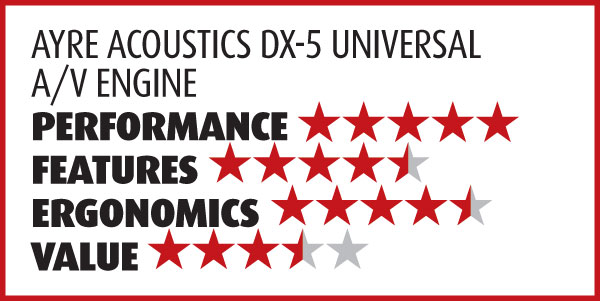Ayre Acoustics DX-5 Universal A/V Engine Page 3
Silver Video Discs
For use as a USB DAC, the DX-5 requires virtually no setup. But it’s a little unusual to use as a BD player if you use the dedicated HDMI audio out (and you should). Through that output, the player converts Dolby TrueHD and DTS-HD Master Audio to multichannel PCM. You can output a Dolby TrueHD or DTSHD Master Audio bitstream directly from the player, but only through its HDMI A/V output. The DX-5 ships from the factory with the correct default settings for Audio Format Setup and Audio Processing, and these settings are repeated in the user manual should you need to enter them manually.

This isn’t the first high-end-priced player I’ve seen—or the first I’ve used directly connected over HDMI to a front projector in my system (in this case, the JVC DLA-X7 reviewed in HT’s May 2011 issue). It’s just the first one I’ve seen that actually looks better in comparison to other players I’ve seen over HDMI. In addition to the superb deintleracing and scaling I mentioned earlier, our battery of standard test patterns revealed sharp, essentially perfect response at the frequency extremes with luma and chroma. The DX-5 fully revealed the highest frequencies in these patterns, and the vertical lines looked crisper than they did with the OPPO BDP-95 I used for comparison (also a direct feed to the JVC DLA-X7). Yet there was no implication that the frequencies were peaked or overemphasized. There was just an almost indescribable sensation that there was a little more of something (or everything) there.
This feeling persisted as I started watching program material on Blu-ray. I consistently found my eyes lingering on certain details that hadn’t seemed as palpable on previous viewings with other players. A little extra shadow detail here, some more fabric texture there, a finer rendering of film grain, etc. There was always something. And this surprised me. With episodes of HBO’s Deadwood, I was especially attuned to the disparity between the softer, noisier interior shots and the crisp photography in the outdoor sequences. With Welcome to the Rileys and especially David Fincher’s The Social Network, I was really impressed by the low-level and shadow detail in the darker scenes (which is just about all of The Social Network) and the staggering dimensionality in the images. The DX-5’s revealing nature wasn’t always to a given movie’s benefit. It also showed a lot of the seams in recent-vintage but not minty-fresh CGI-laden constructs. I rewatched the first three Pirates of the Caribbean movies on Blu-ray, and I’d never seen the complex motion and tight patterns of film grain displayed more smoothly and finely. But I’d also never seen the CGI stand out as conspicuously as it often did with the DX-5.
Essentially, whatever the cinematic intentions were with any given piece of program material, I felt that the DX-5 delivered those intentions with a bit more observable expression. Photography—both film and digital—always looked a little more evocative in terms of texture, gradation, and depth.
But again, these are details. The overall impact was that movies looked and felt more like movies on the DX-5. There was also an easy-on-the-eyes quality to the picture that I haven’t encountered before. I know my comments on the HDMI video output looking better than other players will be met with skepticism. I get it. That’s how I felt before I saw the DX-5. But after I spent time with it and went back and forth between it and the other players I had on hand, I unequivocally looked forward to watching movies on the DX-5 more than with any other Blu-ray player I’ve ever used. I know a lot of us like to think that it’s all just 1s and 0s and that digital is digital. And often, that can be true in good and bad ways. But this is something different. Be brave and experience it before you pooh-pooh it (and me for writing this).
I’d also be remiss if I didn’t mention that the dedicated HDMI audio output also yielded superlative results with movie playback (even compared with the DX-5’s own HDMI A/V output). I particularly noticed an enhanced sense of dynamic punch and resolution with the dedicated output when I compared it to the A/V output. Pixar’s The Incredibles was one of the first Blu-rays I watched on the DX-5, and it was a mind-blower. The action sequences and surround presence were immersive.
I also loved the sweet but detailed treatment of the score, which thematically melds James Bond with a variety of superhero scores to great effect. These supers have never sounded quite this super.
Bridge Building
With the Ayre Acoustics DX-5, the disc player might very well have saved its best for last. The DX-5 not only bridges our disc-based past with our discless future; it also goes substantially further in bridging the still golden sound and tonality of analog with digital audio than any other component I’ve yet encountered. In my opinion, the Ayre Acoustics DX-5 is destined to become a classic, and I recommend it to any videophile, audiophile, or computer audiophile who can afford it. This might well be the last great disc player we ever see and hear, so treat yourself.































































